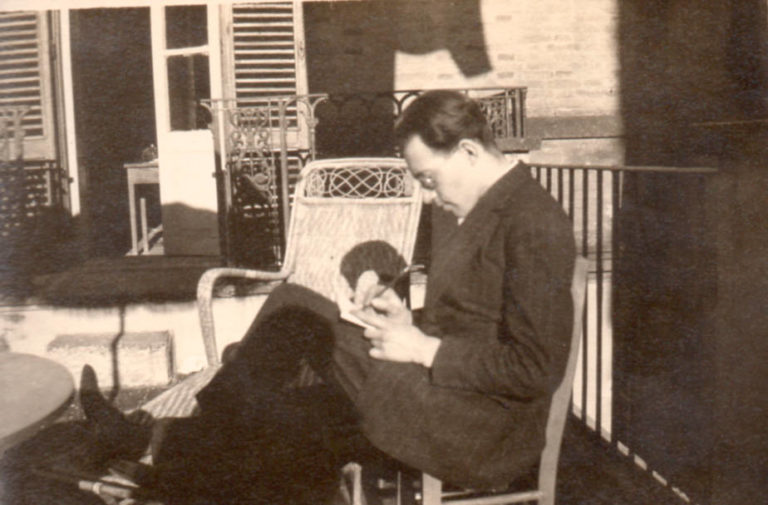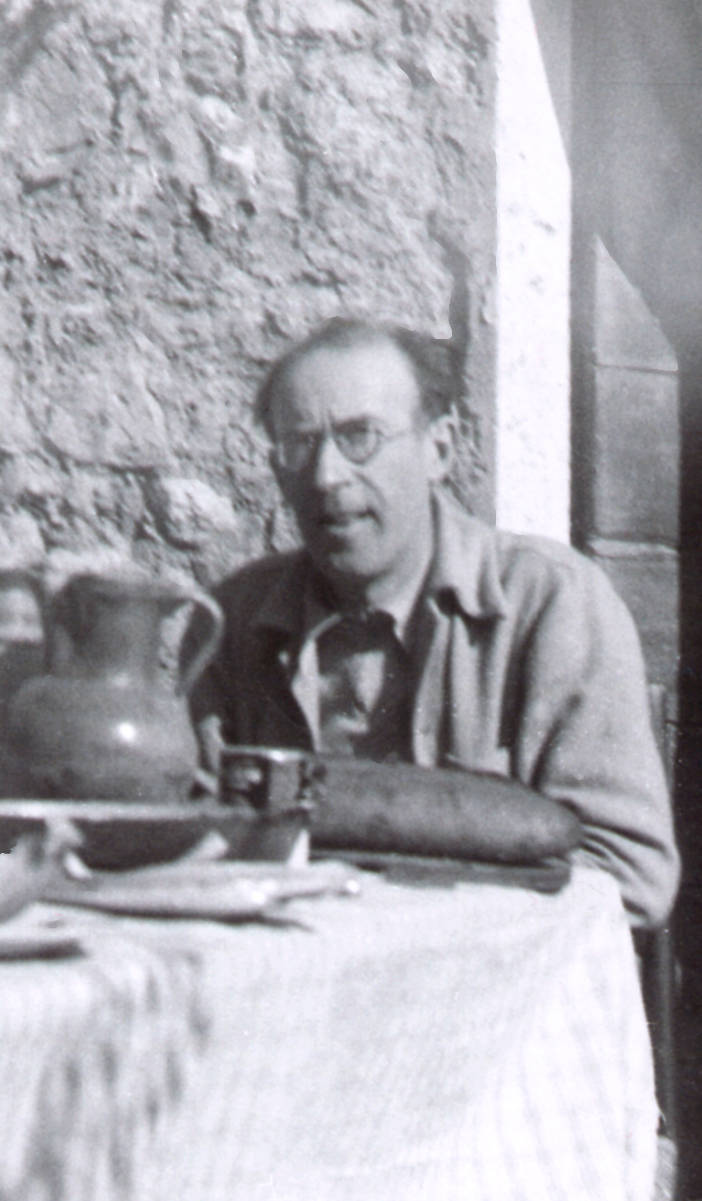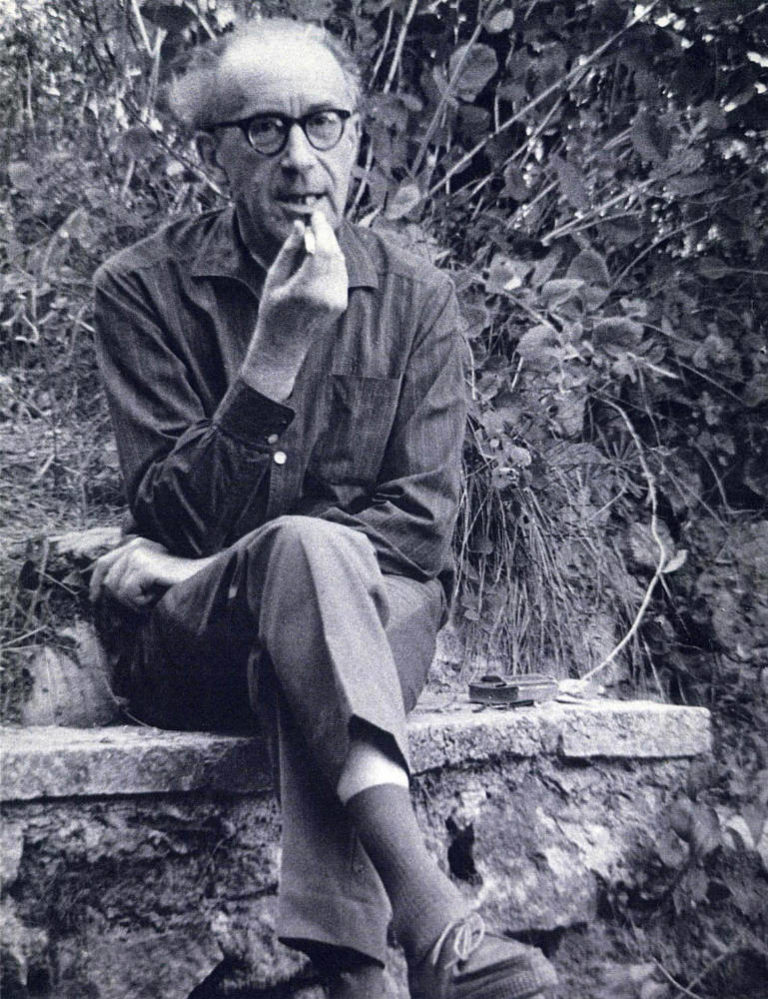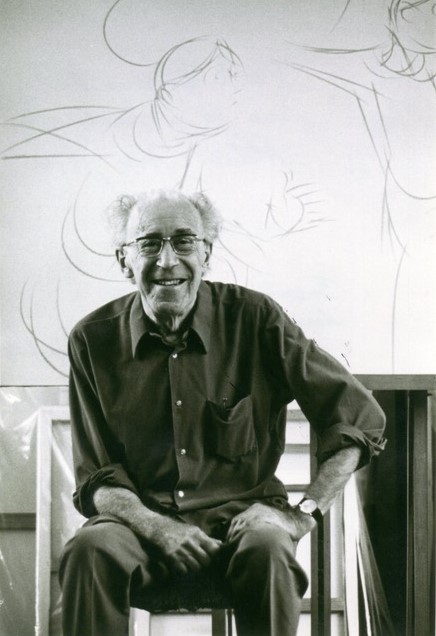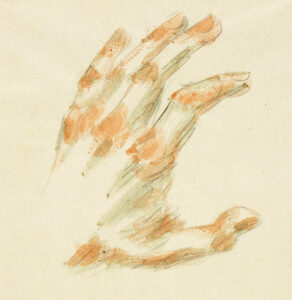About Leo
A short biography
Leo Marchutz, a German-born painter and lithographer, is the subject of a renaissance of interest in his work, with a comprehensive catalogue raisonné underway.
1903 – Born in Nuremberg, Germany. Begins painting at the age of thirteen. Rejects the formal training of several instructors and embarks on an independent study of masterpieces in the museums of Nuremberg, Berlin, and Munich, where he first encounters the work of Cezanne and Van Gogh.
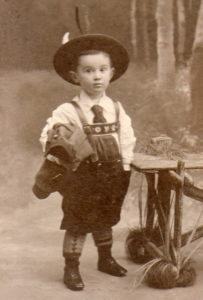 1919 – Sells his first painting in 1919 to Max Reinhardt, renowned Austro-American stage and film director.
1919 – Sells his first painting in 1919 to Max Reinhardt, renowned Austro-American stage and film director.
1921 – First solo exhibit organized by Karl-Ernst Osthaus, patron of the arts and founder of the Folkwang Museum, Hagen, Germany.
Summer of 1928 – Marchutz takes a first trip to Aix-en-Provence, Cezanne’s native city, He permanently immigrates there in 1931 and will become one of the foremost specialists on Cezanne.
1933 – Begins research on Cezanne with John Rewald and Fritz Novotny.
Mid 1930’s – He gradually gives up oil painting to devote himself to drawing, and ultimately, lithography.
1939 to 1940 – Marchutz is detained at the Camp des Milles internment camp near Aix. He barely escapes deporation shortly after his release.
1940 to 1944 – To avoid arrest by Vichy police, Leo Marchutz hides in the surrounding hills of Chateaunoir. He survives with the help of his wife, Barbara and from the products of their poultry farm.
August 1944 – After the liberation of Provence, he actively resumes his artistic work, principally inspired by biblical texts. Devotes himself to mastering lithographic technique, work that culminates in 1949 with the publication of “The Gospel According to Saint Luke”.
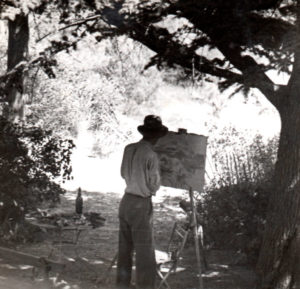 1949 – Perfects a unique technique for color lithography and is solicited by numerous artists, such as Tal Coat, André Masson, Pierre Jean Jouve and Fernand Pouillon, who will become his benefactor. Publishes several series of his own works, including the illustration of biblical texts and the streets of Aix and Italy.
1949 – Perfects a unique technique for color lithography and is solicited by numerous artists, such as Tal Coat, André Masson, Pierre Jean Jouve and Fernand Pouillon, who will become his benefactor. Publishes several series of his own works, including the illustration of biblical texts and the streets of Aix and Italy.
1956 – At the request of the city of Aix he becomes exhibition commissioner. He works on two major Cezanne exhibitions (1956 and 1961) and on an exhibit of Matisse (1960).
1959 – Marchutz is hired by the Institute for American Universities in Aix to teach painting and drawing.
1964 – He resumes painting, creating murals, frescoes and large format paintings on canvas, working from his enlarged drawings.
1972 – In collaboration with two former students, he creates The Leo Marchutz School of Painting and Drawing.
1976 – Leo Marchutz dies in Aix-en-Provence.
LIST OF EXHIBITIONS
1921 – Folkwang Museum, Hagen, Germany Exhibition organized by Karl Ernst Osthaus.
1947 – University of Louisville, Louisville, Kentucky Joint exhibition with the American artist Esther Worden Day.
1957 – Galerie Craven, Paris Exhibit of drawings and lithographs.
1957 – Fraenkische Gallery, Nuremberg, Germany
1960 – The Metropolitan Museum, New York, NY Selections Show, Head of an Apostle.
1969 – Southwestern University, Brooks Memorial Art Gallery, Idlewild Presbyterian Church, Memphis, Tennessee
1969 – Saint Marc Jaumegarde Chapel, France Three paintings: “The Virgin Mary”, “The Angel Gabriel” and “Crucifixion, Mary at the foot of the cross” are put on permanent exhibit in the chapel.
1970 – Galerie d’Art “La Muraille” Besançon, France Joint exhibition with four other painters from Provence.
1972 – Abbaye de Silvacane, La Roque d’Antheron, France Exhibition of Monumental Works.
1973 – St. John’s College, Santa Fe, New Mexico Exhibition.
1977 – Jardin de Flore, Paris Exhibition of lithographs of Aix.
1977 – Bibliothèque Méjanes, Aix-en-Provence, France Retrospective.
1978 – Museum of Tapestries, Aix-en-Provence, France Exhibition “Lights of Leo Marchutz, 50 years of paintings, drawings and lithographs. Exhibit commemorating the 50th anniversary of the arrival of Marchutz in Aix in 1928.
1984 – Saint Marc Jaumegarde, France Inauguration of the Leo Marchutz exhibit room, devoted to the permanent exhibition of a selection of the painter’s work.
1990 – Granet Museum, Aix-en-Provence, France Exhibit, “Cezanne – Saint Victoire”. Organized by the city of Aix, commemorating the research on Cezanne by Leo Marchutz in collaboration with John Rewald.
1992 – Georges Pompidou, Center, Paris Numerous Marchutz lithographs are shown in the exhibit “Pierre-Jean Jouve – Traveller in the Landscape” organized by the BPI (Public Library of Information).
1992 – Arturo Lopez Cultural Center, Neuilly, France Exhibition “Neuilly in Poetry” dedicated to the poet Pierre- Jean Jouve., including lithographs of Aix and Italy, the Lithographic Album of Aix, as well as “The Tongue” by Pierre- Jean Jouve, produced in 1952 by Leo and Barbara Marchutz.
1995/96 – Cezanne’s Studio, Aix-en-Provence, France Exhibition “Pages on Cezanne by a Contemporary Master” Organized by Marianne Bourges of the Atelier Cézanne.
1996 – Granet, Museum Aix-en-Provence, France Conference “Rewald – Cezanne”. Celebrating Cezanne through the eyes of a foreigner, German, American, and French at heart.
1997 – Wayne Art Center, Philadelphia, Pennsylvania Exhibition “Léo Marchutz and Route Cézanne”
1997 – Lighthouse Gallery, Palm Beach, Florida
1997 – Galerie Alain Paire, Aix-en-Provence, France Exhibit “Lithographs of Leo Marchutz, Sainte-Victoire and Street Scenes of Aix”.
1997 – Galerie d’Art Espace 13, Aix-en-Provence, France Exhibition “The Painters of the Camp des Milles: September 1939 to summer of 1940”, organized by the Council General of Bouches-du-Rhône.
2000/2001 – Granet, Museum and Museum of Tapestries, Aix-en-Provence Exposition “Ecole Marchutz Aix, 25 ans”.
2006 – Exhibits organized for the exhibition “Cezanne in Provence” commemorating the centenial of the death of Paul Cezanne:
– Granet Museum, Aix-en-Provence, France “Hommage to Leo Marchutz”.
– Galerie d’Art Amana, Aix-en-Provence, France Paintings, lithographs and drawings of Leo Marchutz.
– Galerie Imbernon, Marseille, France Leo Marchutz exhibition.
– City and Chapel of Saint Marc Jaumegarde, France Exhibition Leo Marchutz. Opening of the permanent exhibit of monumental works of Leo Marchutz, inspired by the biblical texts from “The Gospel According to Saint Luke.”
2013 – Exhibits on the theme “Leo Marchutz, Painter and Lithographer“, organized in conjunction with “Marseille-Provence 2013, European Capital of Culture.
– Cezanne’s Studio, Aix-en-Provence, France “The Motif of the Saint Victoire Mountain”.
– Exhibition Space ,Tourist Office, Aix-en-Provence , France “Venice, Northern Italy and the Streets of Aix.”
– Saint-Marc Jaumegarde Chapel, France “Eight works Inspired by the Gospel According to Saint Luke.”
– Galerie Vincent Bercker, Aix-en-Provence, France “Drawings and Lithographs”.
– Atelier Marchutz/Pouillon “Large Formats, Monumental Works”.
– Institute for American Universities “Large Formats and the Saint Victoire Mountain mural painting”.
2013 – Grand Salon, Jas de Bouffan, Aix-en-Provence, France Exhibition/Conference “Leo Marchutz and his Work”. Marchutz was chosen as person of honor by the city of Aix for the Days of European Heritage.
2015 – Camp des Milles, Memorial Site, Aix-en-Provence, France Concert/Presentation “Leo Marchutz, a Portrait in Music”. Original music by Marc-Olivier Dupin. Interpretation: The Marseille Wind Quintet. Presenter/Interpreter: Benoït Marchand. Image Projection: Laurent Sarazin.
2016/2017 – Camp des Milles, Memorial Site, Aix-en-Provence, France Exhibition “Create in Order to Resist: From Nuremberg to Aix-en-Provence”. The exhibit presented artworks from 1918 to 1949, the majority of which were shown to the public for the first time.
2017 – Galerie Vincent Bercker, Aix-en-Provence, France Exhibit “Eight Paintings from the 1930’s”.
2019 – Institut Franco-Allemand, Tubingen, Germany From Nuremberg to Aix-en-Provence.
2019 – Galerie Vincent Bercker, Aix-en-Provence, France Exhibition of lithographs of Venice.
THE EARLY YEARS of his life read like a book… Son of a wealthy German industrialist of Jewish descent, child prodigy, Leo Marchutz began painting at 13. He sold his first work of art at age 16.
Rejecting formal artistic training, he preferred the independent study of masterpieces in the museums of Nuremberg, Berlin, and Munich, where he first encountered the works of Cezanne and Van Gogh. Drawn to Provence to study the motifs of these two masters, Marchutz immigrated permanently to Aix-en-Provence, France in 1931.
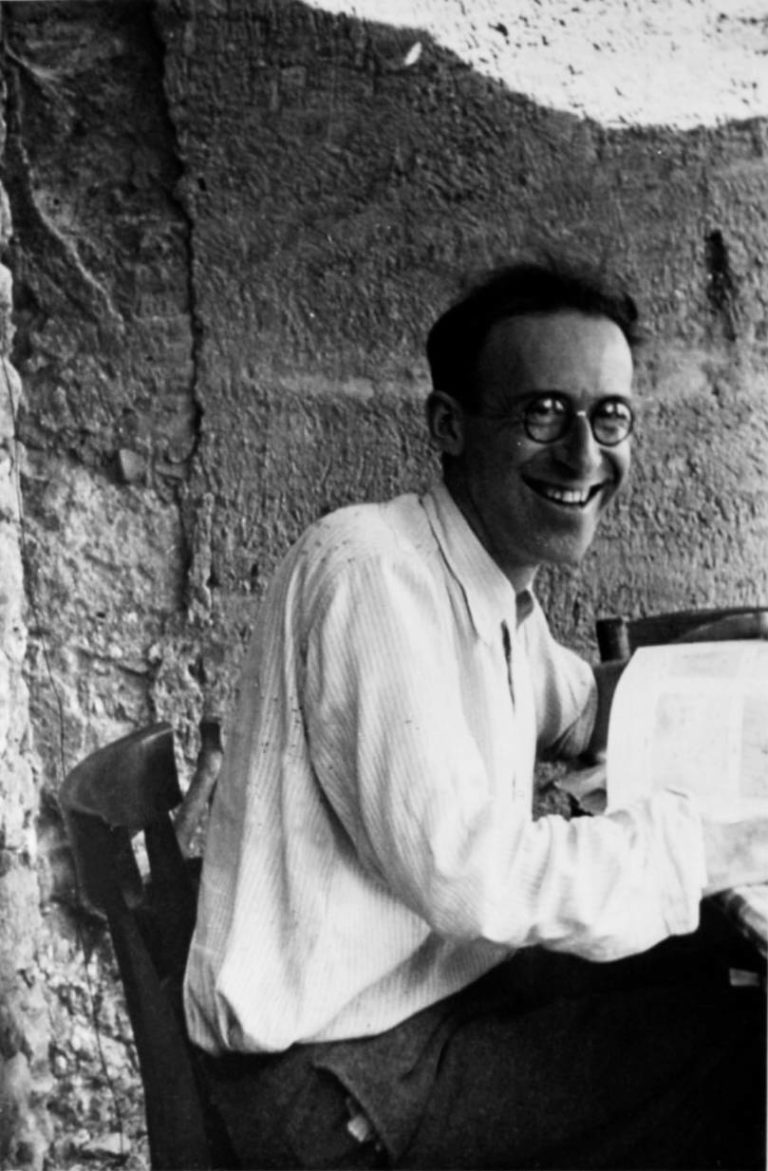
HIS CAREER was abruptly interrupted at the onset of WWII. As a German national, he was considered an “enemy alien” and was interned at the Camp des Milles, the largest internment camp in the south of France.
Once released, he barely escaped arrest, first by Vichy police, then by the Gestapo. He was forced into hiding, where he would remain for four years to avoid deportation… Dispossessed, his family fled Germany and immigrated to America.
THE LIFE OF LEO MARCHUTZ echoes the trials of his century. His artwork reflects the quiet determination of a man who knew his calling.
